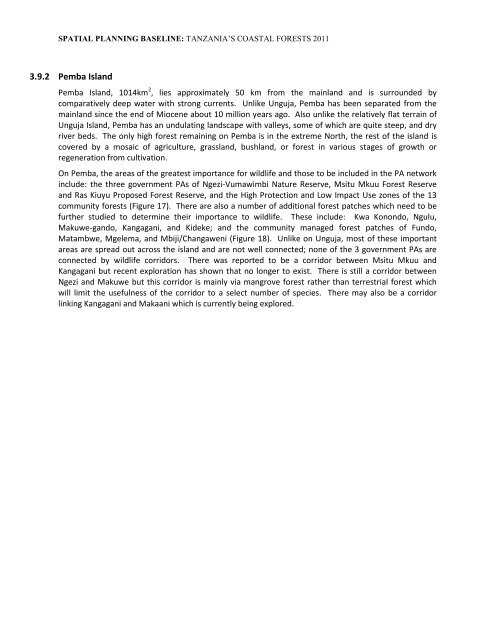Neil D. Burgess, Paul Harrison, Peter Sumbi, James Laizer, Adam ...
Neil D. Burgess, Paul Harrison, Peter Sumbi, James Laizer, Adam ...
Neil D. Burgess, Paul Harrison, Peter Sumbi, James Laizer, Adam ...
Create successful ePaper yourself
Turn your PDF publications into a flip-book with our unique Google optimized e-Paper software.
SPATIAL PLANNING BASELINE: TANZANIA’S COASTAL FORESTS 2011<br />
3.9.2 Pemba Island<br />
Pemba Island, 1014km 2 , lies approximately 50 km from the mainland and is surrounded by<br />
comparatively deep water with strong currents. Unlike Unguja, Pemba has been separated from the<br />
mainland since the end of Miocene about 10 million years ago. Also unlike the relatively flat terrain of<br />
Unguja Island, Pemba has an undulating landscape with valleys, some of which are quite steep, and dry<br />
river beds. The only high forest remaining on Pemba is in the extreme North, the rest of the island is<br />
covered by a mosaic of agriculture, grassland, bushland, or forest in various stages of growth or<br />
regeneration from cultivation.<br />
On Pemba, the areas of the greatest importance for wildlife and those to be included in the PA network<br />
include: the three government PAs of Ngezi-Vumawimbi Nature Reserve, Msitu Mkuu Forest Reserve<br />
and Ras Kiuyu Proposed Forest Reserve, and the High Protection and Low Impact Use zones of the 13<br />
community forests (Figure 17). There are also a number of additional forest patches which need to be<br />
further studied to determine their importance to wildlife. These include: Kwa Konondo, Ngulu,<br />
Makuwe-gando, Kangagani, and Kideke; and the community managed forest patches of Fundo,<br />
Matambwe, Mgelema, and Mbiji/Changaweni (Figure 18). Unlike on Unguja, most of these important<br />
areas are spread out across the island and are not well connected; none of the 3 government PAs are<br />
connected by wildlife corridors. There was reported to be a corridor between Msitu Mkuu and<br />
Kangagani but recent exploration has shown that no longer to exist. There is still a corridor between<br />
Ngezi and Makuwe but this corridor is mainly via mangrove forest rather than terrestrial forest which<br />
will limit the usefulness of the corridor to a select number of species. There may also be a corridor<br />
linking Kangagani and Makaani which is currently being explored.

















